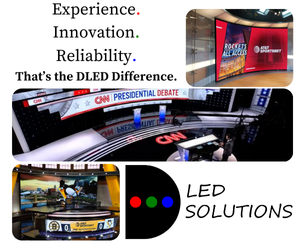NAB Show Perspectives: The trends defining the future of media in 2025

Subscribe to NewscastStudio for the latest news, project case studies and product announcements in broadcast technology, creative design and engineering delivered to your inbox.
As we move into 2025, we are already witnessing seismic shifts in the media landscape. Innovations in artificial intelligence, Adtech, streaming, and production workflows are reshaping the way content is created, distributed, and monetized.
Here are some key trends I think will define the media industry in 2025:
Artificial intelligence
AI will play an even larger role in content creation, personalization, and audience engagement. Expect to see AI-powered scriptwriting, video editing, and real-time deepfake applications become mainstream. AI-driven recommendation engines will enhance user experiences, while generative AI will assist in creating hyper-personalized marketing campaigns and automated news production.
Adtech: Programmatic advertising and addressable ads
Programmatic advertising will become more sophisticated, leveraging AI and real-time data to deliver hyper-targeted campaigns. Addressable ads, which allow advertisers to customize messaging for specific audiences, will become more prevalent across Connected TV (CTV) and streaming platforms. Privacy regulations and cookie deprecation will push the industry toward alternative targeting methods, such as contextual and first-party data strategies.
Monetization
Media companies will diversify their revenue streams, with an emphasis on subscription models, microtransactions, and hybrid ad-supported content. Blockchain technology may also see greater adoption for transparent royalty payments and digital rights management (DRM). Streaming platforms will experiment with dynamic pricing models, allowing consumers to pay for content based on demand or engagement levels.
Streaming: Online distribution, connected TV, and FAST
The rise of free ad-supported streaming television (FAST) will continue, offering consumers more choices outside of traditional pay-TV and subscription-based services. Streaming providers will expand their reach through global partnerships and investments in localized content. AI-driven recommendations will optimize content discovery, while 5G and improved broadband infrastructure will enhance streaming quality and reduce latency.
CDN log ingestion into analytics
CDN logs accurately monitor bandwidth consumption. By combining these logs with customer data, video providers can monitor best and worst performing CDNs. Peaks in bad CDN responses help support teams manage end-user QoE, as well as any QoS gaps in their network infrastructure. CDN logs are also crucial in evaluating piracy. If CDN consumption is much higher than video plays, it means the video player is embedded somewhere that has not been approved.
New ways to consume content
Consumers will increasingly engage with content across multiple platforms and devices. The rise of interactive and immersive experiences, such as augmented reality (AR) and virtual reality (VR), will redefine how audiences consume media. Short-form content, live shopping, and social-driven video formats will dominate, particularly among younger demographics. These shorts are going to be scripted by AI and proliferated by AI.
Sports production
Advancements in real-time data analytics, automated camera systems, and AI-powered highlights will revolutionize sports broadcasting. Interactive viewing options, such as multi-angle streaming and second-screen experiences, will enhance fan engagement. Augmented reality overlays and 3D replays will become more common, providing deeper insights into game strategies and player performances.
Remote and cloud-based production
User-centric cloud-based production workflows will become the industry standard, enabling remote collaboration and reducing operational costs. AI-driven automation in editing and post-production will streamline workflows, making content creation more efficient. With an emphasis on user personalisation, expect an increase in virtualized production environments where teams work seamlessly across different geographies.
NextGen TV
The transition to ATSC 3.0 (NextGen TV) will continue, bringing higher-resolution video, improved audio quality, and enhanced interactivity to over-the-air broadcasts. Personalized content delivery and advanced emergency alert systems will improve viewer experiences. Broadcasters will explore new business models, such as interactive advertising and subscription-based local channels.
Efficiency and workflow
AI and machine learning will drive efficiency across the media production pipeline, automating repetitive tasks such as metadata tagging, asset management, and video indexing. Cloud-based collaboration tools will optimize team workflows, enabling faster turnaround times. Sustainability will also become a key focus, with media companies adopting greener production practices and reducing carbon footprints. Efficiency means you need to know what bandwidth is necessary for providing the best quality per consumer.
Virtual production
Virtual production techniques, utilizing LED walls and real-time rendering engines, will continue to replace traditional green screen methods. These technologies will reduce production costs while offering greater creative flexibility. Expect to see more high-quality, immersive storytelling enabled by advancements in Unreal Engine, real-time motion capture, and AI-driven scene generation.
The age of AI-powered media
The media industry in 2025 will be defined by innovation, personalization, and efficiency. As AI and cloud technologies continue to mature, they will shape the future of content creation, distribution, and monetization. Companies that embrace these trends will gain a competitive edge in an increasingly dynamic media landscape.
Subscribe to NewscastStudio for the latest news, project case studies and product announcements in broadcast technology, creative design and engineering delivered to your inbox.





tags
NAB Show 2025, NAB Show News, NPAW, Till Sudworth, trends
categories
Broadcast Business News, Broadcast Engineering, NAB Show, Thought Leadership, Voices